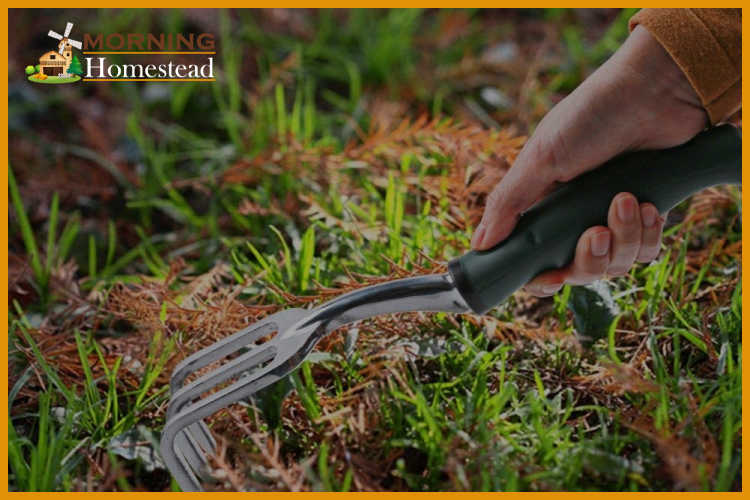Last Updated on June 19, 2023 by Georgie Smith
Year-round vegetable and herb gardening indoors is easy if you have LED grow lights. For many homesteaders around the world, winter sunshine just isn’t enough light for raising food. It needs to be supplemented, or even replaced, with grow lamps.
It used to be that indoor gardeners depended on high pressure sodium and metal halide lamps. Unfortunately, those HID (high intensity discharge) lights are costly to operate. They run hot, so they need extra ventilation, and they need ballasts for flicker-free light. The bulbs need to be replaced after a year or two of use. And HID lamps use quite a bit of electricity, a resource that’s especially expensive if you’re living off the grid and depending on solar power and a generator.
See Also:
LED grow lights, on the other hand, are not cheap at the outset. You’ll probably pay more for an LED light panel than you would for an HID lamp setup. But the savings come in big time over the long run. You may not need extra ventilation at all because LED lamps run cool and often have their own internal fans.
The bulbs won’t need to be replaced for years, and they don’t need ballasts. And the electricity they consume is about half what the old school lamps need for the same amount of light.
One other factor is the quality of light. LED lamps used for growing usually emit full-spectrum light. They mimic actual sunlight, from ultraviolet and blue up through red and infrared, but focusing on the parts of the band that are essential for photosynthesis. Let’s take a look at a comparison of sodium lamps versus LED lights for growing plants.
Comparison of sodium lamps versus LED lights for growing
| Sodium (High Or Low Pressure) | LED Lights |
|---|---|
| Basic yellow glow, visible light only | Wide range of spectral colors available in various combinations |
| Need time to warm up and cool down, tendency to flicker | Instant on and off, no flicker |
| Not dimmable without changes to the ballast; dimming can shorten bulb lifetime | Dimmable with no problems (feature available on some lamps) |
| 360-degree light emission requires reflectors | 180, 120, or 90-degree emission, can use reflector if needed |
| Much power use converted to heat instead of light, not energy efficient | Energy efficient, consuming 1/3 or less what a comparable HPS lamp uses |
Take note of that last line on the chart—LED grow lights are a great idea if you want to save on electricity.
But how do you know if you have enough light to care for your garden indoors?
How Much Light Do You Need to Raise Plants Indoors?
Some plants require lots of light, others tolerate shade. The first thing you’ll need to do is get acquainted with what your vegetables and herbs need to flourish inside.
General rules of thumb for raising vegetables indoors:
- Root vegetables like carrots and onions need at least six hours of sun or light
- Leafy vegetables like lettuce need at least four hours of light
- Vegetables like tomatoes and peppers (fruiting plants) need the most, at least 8 hours
- Less light is good for germination and sprouting, but fruiting and blooming requires more light
That gives you an idea of how much time you’ll need to run the lamp to supplement winter sunlight, but how big or powerful of a lamp will you need for all your plants?
Choosing the right size light for best coverage and a healthy garden
Lumen ratings measure brightness for human eyes, so they aren’t very helpful for selecting grow lights. Wattage is a measurement of power, but this isn’t helpful either, except for judging how much electricity the light will use. Instead, look at specifications on PAR and the manufacturer’s guidelines on square foot coverage. [1]
PAR
PAR means photosynthetically active radiation. It’s a measurement of the light’s intensity and what colors it emits. PAR measures light emitted in the 400nm to 700nm spectrum, or from blue light into infrared. The higher the PAR number, the more useful the light is for growing plants.
Coverage
Most manufacturers will state information like the area their light covers at certain heights above the canopy of the plant. For example, one might say their lamp illuminates 4 feet by 4 feet at a height of 18 inches. When you’re germinating seeds, you may hang a bright light up higher than this, and therefore you’ll have a larger coverage area.
But when you’re trying to get tomatoes as big and juicy as possible, you’ll want to lower the light closer, which will shrink the area it covers.
Other factors to note
One LED panel may not be large enough to cover all the plants you want to grow. You might need two or more. Look at whether the manufacturer allows daisy-chaining or has another method so you can link the lights together and run them off the same timer.
Take into account the shape of the panel or light, whether it casts a circle, square, or rectangular of illumination. Remember that the light will need to be powerful enough to penetrate foliage in a few weeks. It’s better to buy a more powerful light than you think you’ll need.
Now let’s review the best LED grow lights for growing plants at your homestead.
The top LED grow lights on the Market
The best lights for grow tents and greenhouses at a glance:
| Picture | Product Name | Features |
|---|---|---|
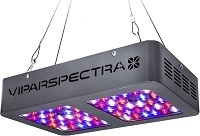 |
VIPARSPECTRA Reflector-Series 300W | – 2 x 2 ft fruiting coverage – 136W consumption – Daisy-chainable – 3 year warranty |
 |
Galaxy Hydro 300W Dimmable | – 2 x 3 ft for vegetation – Daisy-chainable – 2 year warranty |
 |
MEIZHI 300W LED Grow Light | – 1.5 ft2 coverage – 130W consumption |
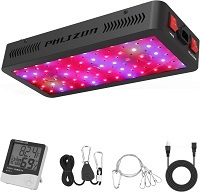 |
MarsHydro Mars600 | – Consumes about 280W – Covers 2 by 1.5-feet for fruiting – 1-year warranty |
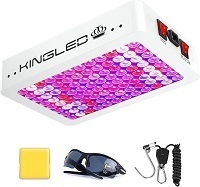 |
King Plus 600w, 800W, 1000W, 1200W | – Uses 10W full-spectrum LEDs – 110-120W consumption – 3-year warranty |
 |
Advanced Platinum Series (300W-1200W) | – Top choice, 5-year warranty – Veg and Bloom switches for brightness control – Full-spectrum 12-band light |
 |
Kessil 350M LED Grow Light 350 | – Very compact, extremely bright – Equivalent to 350W HPS – Covers 2.5ft2 – Magenta color favorable for flowering and fruiting |
VIPARSPECTRA Reflector-Series 300W

Buy On Amazon
The VIPARSPECTRA 300 W has a core coverage area that measures 2 by 2 feet when the panel is hung 2 feet above the leaves of your plants. It only consumes 136 watts of electricity but it can take the place of a 250-watt HPS lamp.
The light comes complete with sixty red and blue LEDs embedded in its surface. Red and blue are essential for photosynthesis throughout the growing season. While some LED lights focus on blue for germination or red for flowering and fruiting, this lamp covers it all.
Each one of the LEDs is rated for 5W, and all of them are sourced from well-known manufacturers like Bridgelux and Epileds. They are placed to shine 90 degrees of light straight down so that not one ray is wasted. This makes the lamp’s purplish illumination very bright, and able to penetrate through a lot of foliage.
The light is cooled by internal fans similar to those found on laptops or inside PC towers. It’s actually pretty quiet while it’s running, more silent than having a separate fan going.
VIPARSPECTRA includes a hanging kit and a 6-foot-long power cord. The panel is quite lightweight at only a hair over 5-1/2 pounds, so it’s very easy to raise and lower and won’t require a heavy-duty framework to support it. It can be daisy-chained to run alongside another 300W light off the same timer.
VIPARSPECTRA offers a 30-day money-back satisfaction guarantee as well as a 3-year warranty. The expected lifetime of the LED bulbs is 100,000 hours of operating time. That’s potentially a decade of work.
Galaxy Hydro 1000W Dimmable

Buy On Amazon
The Galaxy Hydro 1000 Watt panel puts out full spectrum light with a seven-to-one ratio of red to blue LEDs plus UV and IR. The abundance of red light helps when it comes time for fruiting and flowering. This light is dimmable from 0-100% so you can use it on less than full power to supplement daylight when plants are growing in a greenhouse or enclosed porch.
This light is interesting because they include UV LEDs and specifically mentions that UV light can help reduce plant disease. This also means you should consider limiting your eyes’ exposure to the light or wearing LED grow room glasses. It’s hard to believe that a lamp could increase your chances of getting cataracts, but it’s true.
This is intense light. Not only could it harm your eyesight, but it will also alter the colors you see when you observe your plants for problems. Consider getting a pair of protective glasses if you’re serious about indoor growing with LED lamps that utilize UV and IR. These glasses will keep your eyes safe and put colors back to normal while you wear them under the light.
One thing to keep in mind is that this is a small light. It only covers 2 feet by 3 feet at its widest, and that’s for sprouting, not flowering. But, like the VIPARSPECTRA, you can daisy-chain these lights together to cover a larger space.
GalaxyHydro includes a power cord and stainless steel ratchet rope hanger. They offer a 2-year warranty with a 30-day money-back guarantee.
Giixer 1000W LED Grow Light

Buy On Amazon
MEIZHI’s 1000W grow light covers a small area, just 1.5 by 1.5 feet when hung 18 inches above the leaves. That’s really only enough for one or two mature plants. This is a decent grow lamp to supplement daylight in a greenhouse or enclosed porch.
The MEIZHI lamp is powered by Epistar’s 5W LEDs which give it a good PAR value of 300 umol/s (micro-mols/second). It consumes 130W, a little more than a bright incandescent bulb. The company offers a 30-day money-back return policy along with free repair for three months and parts for up to a year.
Phlizon 2022 (600W)

Buy On Amazon
Giixer 600 is quite bright because it uses 5W Epistar red and blue LEDs that emit the full range of light your plants need for photosynthesis. Although it is comparable with a 600W HID lamp, it consumes only 280W of power. The Mars600 is UL-listed for safety. It comes with a one-year warranty.
Some of its LEDs are angled at 90 degrees and others at 120 degrees in order to cover as much area as possible. Even with those accommodations, the light only reaches 2 by 1.5-feet for flowering and fruiting. If you plan to use it for seed germination and sprouting, it covers 2.5 by 2 feet.
King Plus 600w, 800W, 1000W, 1200W

Buy On Amazon
King Plus ships their lights from Hong Kong, but don’t knock the Chinese point of origin until after you consider these specifications plus all the positive user reviews online. They offer a 3-year warranty on each light.
One thing that sets the King Plus series apart is their use of 10W “bulbs” comprised of 2 x 5W LEDs. This way of building is even more energy efficient, using between 110 to 120W of electricity for a 600W light.
The selection of colors makes this a full-spectrum grow lamp. There are 60 pieces total: 39 red, 11 blue, 4 warm white, 4 orange, 1 UV and 1 IR, all Epistar LEDs with an expected lifetime of over 50,000 hours. This grow light is so bright that Kings Plus suggests keeping it 2 to 3.5 feet above the foliage.
Advanced Platinum Series P300

Buy On Amazon
PlatinumLED’s Advanced Platinum Series P300 is one of the best small grow lights on the market. They offer a 90-day money-back satisfaction guarantee plus a 5-year warranty because these lights are built for serious growers. In fact, you’d be in good hands with any one of their Advanced Platinum Series, from the P300 up to the P1200. It just depends on the size of your indoor garden.
The P300’s coverage is 4.5 feet by 3.8 feet at an 18-inch height for germination and vegetation, or core coverage for fruiting at 3 by 2 feet. The 12-band spectrum covers the full range from UV through blue, red, and IR light.
This light is able to replace a 400W HPS light while only using 180 watts of power. There are two switches on the panel that control the intensity. For seed germination and leaf growth, use the “Veg” switch. This saves a little power until you need the full intensity of the light for flowering and fruiting, which is the “Bloom” switch.
The LEDS are all 3W, and each one is replaceable individually, so if one fails you can take care of it without losing your whole panel. Part of the reason why PlatinumLED lights are known for their high quality is that they source top bin LED bulbs from top manufacturers like CREE and Bridgelux.
What does “top bin” mean? LEDs may vary in characteristics although they are made in the same batch at the same factory. “Top bin” means that the LEDs are purposefully selected to be equal in color, voltage, and flux. This means they only use LEDs that pass strict quality controls.
The P300 is easy to hang in a small grow tent as it weighs only 13 pounds. Of course, that’s more than double what the two previous panels weigh, in case that matters in your setup.
Advanced Platinum Series P450
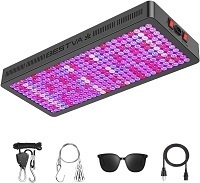
Buy On Amazon
The Advanced Platinum Series P450 is similar to the P300 but it has a slightly larger coverage area. The core illumination where the light is brightest measures 3 feet by 2.5 feet, half a foot wider than the P300. But if you need more power, try the P600 below.
Advanced Platinum Series P600

Buy On Amazon
The P600 can cover 2 feet by 5 feet for the “Bloom” phase or fruiting. The “Veg” coverage area is even larger, measuring 6 feet by 3.75 feet when the light is 18 inches above the foliage. Keep in mind this is a rectangular panel, which is ideal if you have a hydroponic setup or a table with one or two rows of pots.
Besides the P300, the P450, and the P600, PlatinumLED has even larger lights like the P900 and the P1200. The P1200 can cover up to 6 by 5.5 feet at when hung at an 18-inch height. If you have a large space to cover, a lot of plants to grow, but your budget prohibits buying an expensive light, try this solution below.
COB LEDs are brighter and bigger than traditional LEDs
COB, or “chip on board” LEDs, are multiple chips packaged together. The COB LED “bulb” doesn’t even look like a bulb at all, but it generates more light than regular LEDs that would fit into the same amount of space. The COB viewing angle is wider than other LEDs without using lenses to create that effect.
COBs have low failure rates than other LED lights because they have fewer soldered parts. They run cooler than traditional LED panels, and much cooler than HPS or MH lamps. COB LED lights are gaining in popularity because they are less expensive and even more efficient.
Bestva X5 COB LED
Bestva’s COB LED light is super bright and powerful for its small size. Bestva measured the PAR of the 1000W light at a 20-inch height from the top of the plant leaves. The PAR rating there was 2170. Even at the highest recommended height of 6.56 feet above the canopy, the panel puts out a PAR of 670.
To put that into perspective, the minimum PAR that some indoor gardeners recommend is 600 umol/s. So the Bestva 1000W light exceeds the minimum even at its maximum recommended distance.
The 600W light from Bestva is also excellent. The PPFD is 430umol/s at an 18-inch height. PPFD is a little different from PAR. It’s a measurement of photosynthetic photon flux density. We’ll take a brief detour below to explain it. In the meantime, here’s the rest of the story about the Bestva lights.
The 600W panel consumes a measly 125W of electricity. When hung two feet above your plants, it illuminates an area measuring 4 feet by 3.6 feet. It comes with a 3-year warranty plus a 30-day money-back satisfaction guarantee, the same as the 1000W lamp.
The Bestva 1000W lamp consumes 185W and covers up to 5.1 by 4.7 feet when hung two feet above the plants. In both cases, the Bestva panels don’t concentrate only on the middle of the area. Their LED chips are focused at 120 degrees to spread out the light evenly. Now let’s talk about the quality of that light.
Kessil 350M LED Grow Light 350

Buy On Amazon
The Kessil Horticulture’s 350M compact grow light doesn’t look like all the other LED lamps we’ve discussed so far. This is an innovative technology that blends 4 colors together to produce an extremely bright beam of light that penetrates deep into the foliage. It’s like a plant-growing spotlight with a magenta glow. It’s perfect for flowering and fruiting plants in an area not more than 2.5 by 2.5 feet in size.
Instead of a traditional built-in fan or passive cooling, the Kessel has a vapor cooling thermal management system, a fancy way of saying it moves heat quickly away from the 90W LED chips inside. The chipset is called a Dense Matrix MEDTM platform. This new design is key to producing as bright a light as possible with as little energy lost to heat as possible.
If you prefer a powerful light for vegetation, Kessil also makes a purple grow light that also works for every stage of plant growth in a circular 2 to 3-foot diameter zone.
PAR versus PPFD
For the layperson, all this talk about PAR and PPFD can be a little dry. But for serious horticulturalists growing indoors, it’s essential information.
PAR is something we touched on earlier in this review. PPFD is what we’ll explain now.
Photosynthetic photon flux density measures the number of photons that fall on a square meter of space. It’s the amount of PAR or photosynthetically active radiation that arrives at the plant. The best way to check this is to take a series of measurements and get the average of all of them. A PPFD of 1500 is good for plants that demand a lot of sunlight.
DLI is one other measurement of interest to growers. It stands for Daily Light Integral, which is the PPFD over the course of a day (or cycle of light). A DLI of 65 is good for plants that need strong light.
FAQs about growing plants indoors
There’s always something new to learn about gardening indoors. Here are some answers to frequently asked questions.
Q: What about raising plants with CFL and fluorescent lamps?
A: Compact fluorescents work okay for germinating seeds and starting cuttings and clones. T5 fluorescents are used for vegetating plants, but they usually need a supplement red lamp for flowering and fruiting. If you don’t mind having to switch around your lights, by all means, start growing with these lamps.
It’s certainly less expensive than many LED grow lights. But be aware that you may not get the best production from your garden. You’ll also need to change your bulbs each year.
Q: How can I tell if my plants aren’t getting enough light?
A: You can spot a plant that isn’t receiving enough light. Its leaves will look pale, not rich green, and flush with chlorophyll. Its growth will be stunted or it may start stretching—building long stems with few leaves. And it will probably begin to lean toward the source of light.
Q: If I live in a zone where there is very little sunlight, or if I have plants that demand a lot of light?
A: Plants need their rest time just like humans, so leaving the grow light on all night isn’t the best way to speed up their growth. They may fail to flower, their leave may wilt or burn, and their size will be stunted.
Q: What color light is most important for raising plants indoors?
A: NASA scientists discovered that both red and blue light is best for growing plants indoors. Blue helps with building foliage while red stimulates the production of flowers and fruits. That’s why you’ll see that many LED grow lights have a purple glow.
Too much UV can burn a plant just like it can a human and too much IR can, too. There is evidence that green light is minimally helpful to plant growth, but yellow is not useful—plants simply reflect it without absorbing it.
Conclusion
We’re always adding new reviews of the best products for homesteading. We hope we helped you find the best LED grow light for your garden today. Check back with us again soon to see the top tools for raising your own food and so much more.




